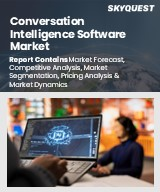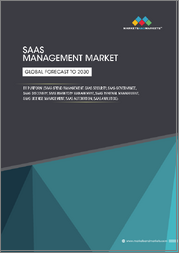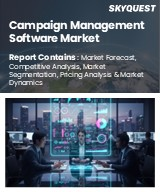
|
시장보고서
상품코드
1782692
세계의 SaaS(Software as a Service) 시장 조사 보고서 : 산업 분석, 규모, 점유율, 성장, 동향, 예측(2025-2033년)Global Software as a Service (SaaS) Market Research Report- Industry Analysis, Size, Share, Growth, Trends and Forecast 2025 to 2033 |
||||||
세계의 SaaS(Software as a Service) 시장 규모는 2024년 2,805억 1,000만 달러에서 2033년에는 1조 4,824억 9,000만 달러로 성장할 것으로 예상되며, 2026년에서 2033년의 예측 기간 동안 20.32%의 견조한 연평균 성장률을 나타낼 전망입니다.
SaaS(Software as a Service) 시장은 비즈니스 효율성을 높이고 비용을 절감하기 위해 클라우드 기반 솔루션을 채택하는 기업이 늘고 있기 때문에 큰 성장을 이루고 있습니다. SaaS는 온프레미스의 대규모 인프라를 필요로 하지 않고 인터넷을 통해 소프트웨어 용도에 액세스할 수 있는 유연성을 조직에 제공합니다. 이러한 추세는 진화하는 요구에 부응하기 때문에 합리적인 가격으로 확장 가능한 솔루션을 요구하는 중소기업에서 특히 두드러집니다. 자동 업데이트, 원격 액세스, IT 오버헤드 감소 등 SaaS의 이점을 인식하는 기업이 늘어남에 따라 소프트웨어 개발 및 딜리버리 모델의 혁신에 힘입어 시장이 더욱 확대될 것으로 예측됩니다.
게다가 디지털 전환이 강조되는 것은 SaaS(Software as a Service) 시장에 큰 영향을 미쳤습니다. 기업이 비즈니스에 기술 통합을 선호하는 동안 협업, 데이터 관리 및 고객 참여를 촉진하는 SaaS 솔루션에 대한 수요가 증가하고 있습니다. 의료, 금융, 소매 등의 업계에서는 SaaS 용도를 활용하여 프로세스를 간소화하고 서비스 제공을 개선하는 움직임이 가속화되고 있습니다. 기업은 생산성을 높이고 성장을 가속하는 도구를 찾고 있기 때문에 이러한 디지털 솔루션으로의 전환은 SaaS(Software as a Service) 시장을 촉진할 것으로 예측됩니다.
또한 기술의 발전으로 SaaS의 기능도 향상되었습니다. 인공지능(AI), 머신러닝 및 데이터 분석의 혁신으로 SaaS 제산업체는 보다 개인화된 지능형 솔루션을 제공할 수 있습니다. 이러한 기술을 통해 기업은 데이터에서 인사이트를 얻고 프로세스를 자동화하고 의사 결정을 개선할 수 있습니다. SaaS(Software as a Service) 시장이 이러한 동향과 기술의 진보를 계속 받아들이면 지속적인 성장이 기대되고 소프트웨어 업계에서 중요한 기업로서의 지위가 확고해질 것입니다.
우리의 보고서는 다양한 산업 및 시장에 대한 종합적이고 실용적인 인사이트를 고객에게 제공하기 위해 철저히 작성되었습니다. 각 보고서에는 시장 상황을 완전히 이해하는 몇 가지 중요한 요소가 포함되어 있습니다.
시장 개요 : 정의, 분류, 업계의 현황에 대한 개요 등 시장에 대한 상세한 소개를 제공합니다.
시장 역학 : 시장성장에 영향을 미치는 주요 촉진요인 및 억제요인·기회·과제를 상세하게 분석합니다. 이 섹션에서는 기술 발전, 규제 변경, 새로운 동향 등의 요인을 확인합니다.
세분화 분석 : 제품 유형, 용도, 최종 사용자, 지역 등의 기준에 따라 시장을 명확한 부문으로 분류합니다. 이 분석은 각 부문의 성과와 미래를 밝혀줍니다.
경쟁 구도 : 시장 점유율, 제품 포트폴리오, 전략적 이니셔티브, 재무 실적 등 주요 시장 기업의 종합적 평가입니다. 주요 기업이 채용하는 경쟁 역학과 주요 전략에 대한 고찰을 제공합니다.
시장 예측 : 과거 데이터와 현재 시장 상황에 따라 일정 기간 동안 시장 규모와 성장 동향을 예측합니다. 여기에는 정량적 분석과 향후 시장 궤적을 보여주는 그래프 표시가 포함됩니다.
지역 분석 : 다양한 지리적 지역에서 시장 성과를 평가하고 주요 시장과 지역 동향을 파악합니다. 지역 시장 역학과 비즈니스 기회를 이해하는 데 도움이 됩니다.
새로운 동향과 기회 : 현재 시장 동향과 새로운 시장 동향, 기술 혁신, 잠재적인 투자 대상 분야를 파악합니다. 미래 시장 개척과 성장 전망에 대한 인사이트를 제공합니다.
목차
제1장 서문
제2장 주요 요약
- 시장의 하이라이트
- 세계 시장 현황
제3장 SaaS(Software as a Service) 산업 분석
- 서론 : 시장 역학
- 시장 성장 촉진요인
- 시장 성장 억제요인
- 기회
- 업계 동향
- Porter's Five Forces 분석
- 시장 매력 분석
제4장 밸류체인 분석
- 밸류체인 분석
- 원재료 분석
- 원재료 리스트
- 원재료 제조업체 리스트
- 주요 원재료의 가격 동향
- 잠재적 구매자 목록
- 마케팅 채널
- 직접 마케팅
- 간접 마케팅
- 마케팅 채널 발전 동향
제5장 세계의 SaaS(Software as a Service) 시장 분석 : 배포 유형별
- 개요 : 배포 유형별
- 실적·예측 데이터 분석 : 배포 유형별
- 퍼블릭
- 프라이빗
- 하이브리드
제6장 세계의 SaaS(Software as a Service) 시장 분석 : 용도별
- 개요 : 용도별
- 실적·예측 데이터 분석 : 용도별
- 고객 관계 관리(CRM)
- 전자석 자원 관리(ERP)
- 컨텐츠, 협업, 커뮤니케이션
- BI 및 애널리틱스
- 인적 자본 관리
- 기타
제7장 세계의 SaaS(Software as a Service) 시장 분석 : 기업 유형별
- 개요 : 기업 유형별
- 실적·예측 데이터 분석 : 기업 유형별
- 대기업
- 중소기업
제8장 세계의 SaaS(Software as a Service) 시장 분석 : 산업별
- 개요 : 산업별
- 실적·예측 데이터 분석 : 산업별
- IT 및 통신
- BFSI
- 소매 및 소비재
- 헬스케어
- 교육
- 제조
- 기타(여행 및 접객)
제9장 세계의 SaaS(Software as a Service) 시장 분석 : 지역별
- 지역별 전망
- 서론
- 북미의 매출 분석
- 개요, 분석과 예측
- 북미 : 부문별
- 북미 : 국가별
- 미국
- 캐나다
- 멕시코
- 유럽의 매출 분석
- 개요, 분석과 예측
- 유럽 : 부문별
- 유럽 : 국가별
- 영국
- 프랑스
- 독일
- 이탈리아
- 러시아
- 기타 유럽
- 아시아태평양의 매출 분석
- 개요, 분석과 예측
- 아시아태평양 : 부문별
- 아시아태평양 : 국가별
- 중국
- 인도
- 일본
- 한국
- 호주
- 동남아시아
- 기타 아시아태평양
- 라틴아메리카의 매출 분석
- 개요, 분석과 예측
- 라틴아메리카 : 부문별
- 라틴아메리카 : 국가별
- 브라질
- 아르헨티나
- 페루
- 칠레
- 기타 라틴아메리카
- 중동 및 아프리카의 매출 분석
- 개요, 분석과 예측
- 중동 및 아프리카 : 부문별
- 중동 및 아프리카 : 국가별
- 사우디아라비아
- 아랍에미리트(UAE)
- 이스라엘
- 남아프리카
- 기타 중동 및 아프리카
제10장 SaaS(Software as a Service) 기업 경쟁 구도
- SaaS(Software as a Service) 시장 경쟁
- 파트너십/제휴/합의
- 합병 및 인수
- 신제품 발표
- 기타 개발
제11장 기업 프로파일
- 주요 기업의 시장 점유율 분석
- 시장 집중도
- Microsoft Corporation
- SAP SE
- IBM Corporation
- Oracle Corporation
- HPE
- ServiceNow
- TCS
- Google LLC
- Cisco Systems Inc.
- Infosys
- Babbel
- Zoho Corporation
- Workiva
- Tecent Holdings
- Trend Micro
Global Software as a Service (SaaS) Market size is anticipated to grow from USD 280.51 Billion in 2024 to USD 1482.49 Billion by 2033, showcasing a robust Compound Annual Growth Rate (CAGR) of 20.32% during the forecast period of 2026 to 2033.
The Software as a Service (SaaS) market is experiencing significant growth as businesses increasingly adopt cloud-based solutions to enhance operational efficiency and reduce costs. SaaS offers organizations the flexibility to access software applications over the internet without the need for extensive on-premises infrastructure. This trend is particularly evident among small and medium-sized enterprises (SMEs) that seek affordable and scalable solutions to meet their evolving needs. As more companies recognize the benefits of SaaS, including automatic updates, remote accessibility, and reduced IT overhead, the market is expected to expand further, driven by innovations in software development and delivery models.
Moreover, the growing emphasis on digital transformation is significantly influencing the SaaS market. As organizations prioritize the integration of technology into their operations, there is a rising demand for SaaS solutions that facilitate collaboration, data management, and customer engagement. Industries such as healthcare, finance, and retail are increasingly leveraging SaaS applications to streamline processes and improve service delivery. This shift towards digital solutions is expected to propel the SaaS market, as businesses seek tools that enhance productivity and drive growth.
Additionally, advancements in technology are enhancing the capabilities of SaaS offerings. Innovations in artificial intelligence (AI), machine learning, and data analytics are enabling SaaS providers to deliver more personalized and intelligent solutions. These technologies allow businesses to gain insights from their data, automate processes, and improve decision-making. As the SaaS market continues to embrace these trends and technological advancements, it is expected to experience sustained growth, solidifying its position as a key player in the software industry.
Our reports are meticulously crafted to provide clients with comprehensive and actionable insights into various industries and markets. Each report encompasses several critical components to ensure a thorough understanding of the market landscape:
Market Overview: A detailed introduction to the market, including definitions, classifications, and an overview of the industry's current state.
Market Dynamics: In-depth analysis of key drivers, restraints, opportunities, and challenges influencing market growth. This section examines factors such as technological advancements, regulatory changes, and emerging trends.
Segmentation Analysis: Breakdown of the market into distinct segments based on criteria like product type, application, end-user, and geography. This analysis highlights the performance and potential of each segment.
Competitive Landscape: Comprehensive assessment of major market players, including their market share, product portfolio, strategic initiatives, and financial performance. This section provides insights into the competitive dynamics and key strategies adopted by leading companies.
Market Forecast: Projections of market size and growth trends over a specified period, based on historical data and current market conditions. This includes quantitative analyses and graphical representations to illustrate future market trajectories.
Regional Analysis: Evaluation of market performance across different geographical regions, identifying key markets and regional trends. This helps in understanding regional market dynamics and opportunities.
Emerging Trends and Opportunities: Identification of current and emerging market trends, technological innovations, and potential areas for investment. This section offers insights into future market developments and growth prospects.
SEGMENTATION COVERED IN THE REPORT
By Deployment Type
- Public
- Private
- Hybrid
By Application
- Customer Relationship Management (CRM)
- Enterprise Resource Planning (ERP)
- Content, Collaboration & Communication
- BI & Analytics
- Human Capital Management
- Others
By Enterprise Type
- Large Enterprises
- SMEs
By Industry
- IT & Telecom
- BFSI
- Retail & Consumer Goods
- Healthcare
- Education
- Manufacturing
- Others (Travel & Hospitality)
- COMPANIES PROFILED
- Microsoft Corporation
- SAP SE
- IBM Corporation
- Oracle Corporation
- HPE
- ServiceNow
- TCS
- Google LLC
- Cisco Systems Inc.
- Infosys
- Babbel
- Zoho Corporation
- Workiva
- Tecent Holdings
- Trend Micro.
- The above list can be customized.
TABLE OF CONTENTS
1. PREFACE
- 1.1. Report Description
- 1.1.1 Objective
- 1.1.2 Target Audience
- 1.1.3 Unique Selling Proposition (USP) & offerings
- 1.2. Research Scope
- 1.3. Research Methodology
- 1.3.1 Market Research Process
- 1.3.2 Market Research Methodology
2. EXECUTIVE SUMMARY
- 2.1. Highlights of Market
- 2.2. Global Market Snapshot
3. SOFTWARE AS A SERVICE (SAAS) INDUSTRY ANALYSIS
- 3.1. Introduction - Market Dynamics
- 3.2. Market Drivers
- 3.3. Market Restraints
- 3.4. Opportunities
- 3.5. Industry Trends
- 3.6. Porter's Five Force Analysis
- 3.7. Market Attractiveness Analysis
- 3.7.1 Market Attractiveness Analysis By Deployment Type
- 3.7.2 Market Attractiveness Analysis By Application
- 3.7.3 Market Attractiveness Analysis By Enterprise Type
- 3.7.4 Market Attractiveness Analysis By Industry
- 3.7.5 Market Attractiveness Analysis By Region
4. VALUE CHAIN ANALYSIS
- 4.1. Value Chain Analysis
- 4.2. Raw Material Analysis
- 4.2.1 List of Raw Materials
- 4.2.2 Raw Material Manufactures List
- 4.2.3 Price Trend of Key Raw Materials
- 4.3. List of Potential Buyers
- 4.4. Marketing Channel
- 4.4.1 Direct Marketing
- 4.4.2 Indirect Marketing
- 4.4.3 Marketing Channel Development Trend
5. GLOBAL SOFTWARE AS A SERVICE (SAAS) MARKET ANALYSIS BY DEPLOYMENT TYPE
- 5.1. Overview By Deployment Type
- 5.2. Historical and Forecast Data Analysis By Deployment Type
- 5.3. Public Historic and Forecast Sales By Regions
- 5.4. Private Historic and Forecast Sales By Regions
- 5.5. Hybrid Historic and Forecast Sales By Regions
6. GLOBAL SOFTWARE AS A SERVICE (SAAS) MARKET ANALYSIS BY APPLICATION
- 6.1. Overview By Application
- 6.2. Historical and Forecast Data Analysis By Application
- 6.3. Customer Relationship Management (CRM) Historic and Forecast Sales By Regions
- 6.4. Enterprise Resource Planning (ERP) Historic and Forecast Sales By Regions
- 6.5. Content, Collaboration & Communication Historic and Forecast Sales By Regions
- 6.6. BI & Analytics Historic and Forecast Sales By Regions
- 6.7. Human Capital Management Historic and Forecast Sales By Regions
- 6.8. Others Historic and Forecast Sales By Regions
7. GLOBAL SOFTWARE AS A SERVICE (SAAS) MARKET ANALYSIS BY ENTERPRISE TYPE
- 7.1. Overview By Enterprise Type
- 7.2. Historical and Forecast Data Analysis By Enterprise Type
- 7.3. Large Enterprises Historic and Forecast Sales By Regions
- 7.4. SMEs Historic and Forecast Sales By Regions
8. GLOBAL SOFTWARE AS A SERVICE (SAAS) MARKET ANALYSIS BY INDUSTRY
- 8.1. Overview By Industry
- 8.2. Historical and Forecast Data Analysis By Industry
- 8.3. IT & Telecom Historic and Forecast Sales By Regions
- 8.4. BFSI Historic and Forecast Sales By Regions
- 8.5. Retail & Consumer Goods Historic and Forecast Sales By Regions
- 8.6. Healthcare Historic and Forecast Sales By Regions
- 8.7. Education Historic and Forecast Sales By Regions
- 8.8. Manufacturing Historic and Forecast Sales By Regions
- 8.9. Others (Travel & Hospitality) Historic and Forecast Sales By Regions
9. GLOBAL SOFTWARE AS A SERVICE (SAAS) MARKET ANALYSIS BY GEOGRAPHY
- 9.1. Regional Outlook
- 9.2. Introduction
- 9.3. North America Sales Analysis
- 9.3.1 Overview, Historic and Forecast Data Sales Analysis
- 9.3.2 North America By Segment Sales Analysis
- 9.3.3 North America By Country Sales Analysis
- 9.3.4 United States Sales Analysis
- 9.3.5 Canada Sales Analysis
- 9.3.6 Mexico Sales Analysis
- 9.4. Europe Sales Analysis
- 9.4.1 Overview, Historic and Forecast Data Sales Analysis
- 9.4.2 Europe By Segment Sales Analysis
- 9.4.3 Europe By Country Sales Analysis
- 9.4.4 United Kingdom Sales Analysis
- 9.4.5 France Sales Analysis
- 9.4.6 Germany Sales Analysis
- 9.4.7 Italy Sales Analysis
- 9.4.8 Russia Sales Analysis
- 9.4.9 Rest Of Europe Sales Analysis
- 9.5. Asia Pacific Sales Analysis
- 9.5.1 Overview, Historic and Forecast Data Sales Analysis
- 9.5.2 Asia Pacific By Segment Sales Analysis
- 9.5.3 Asia Pacific By Country Sales Analysis
- 9.5.4 China Sales Analysis
- 9.5.5 India Sales Analysis
- 9.5.6 Japan Sales Analysis
- 9.5.7 South Korea Sales Analysis
- 9.5.8 Australia Sales Analysis
- 9.5.9 South East Asia Sales Analysis
- 9.5.10 Rest Of Asia Pacific Sales Analysis
- 9.6. Latin America Sales Analysis
- 9.6.1 Overview, Historic and Forecast Data Sales Analysis
- 9.6.2 Latin America By Segment Sales Analysis
- 9.6.3 Latin America By Country Sales Analysis
- 9.6.4 Brazil Sales Analysis
- 9.6.5 Argentina Sales Analysis
- 9.6.6 Peru Sales Analysis
- 9.6.7 Chile Sales Analysis
- 9.6.8 Rest of Latin America Sales Analysis
- 9.7. Middle East & Africa Sales Analysis
- 9.7.1 Overview, Historic and Forecast Data Sales Analysis
- 9.7.2 Middle East & Africa By Segment Sales Analysis
- 9.7.3 Middle East & Africa By Country Sales Analysis
- 9.7.4 Saudi Arabia Sales Analysis
- 9.7.5 UAE Sales Analysis
- 9.7.6 Israel Sales Analysis
- 9.7.7 South Africa Sales Analysis
- 9.7.8 Rest Of Middle East And Africa Sales Analysis
10. COMPETITIVE LANDSCAPE OF THE SOFTWARE AS A SERVICE (SAAS) COMPANIES
- 10.1. Software as a Service (SaaS) Market Competition
- 10.2. Partnership/Collaboration/Agreement
- 10.3. Merger And Acquisitions
- 10.4. New Product Launch
- 10.5. Other Developments
11. COMPANY PROFILES OF SOFTWARE AS A SERVICE (SAAS) INDUSTRY
- 11.1. Top Companies Market Share Analysis
- 11.2. Market Concentration Rate
- 11.3. Microsoft Corporation
- 11.3.1 Company Overview
- 11.3.2 Company Revenue
- 11.3.3 Products
- 11.3.4 Recent Developments
- 11.4. SAP SE
- 11.4.1 Company Overview
- 11.4.2 Company Revenue
- 11.4.3 Products
- 11.4.4 Recent Developments
- 11.5. IBM Corporation
- 11.5.1 Company Overview
- 11.5.2 Company Revenue
- 11.5.3 Products
- 11.5.4 Recent Developments
- 11.6. Oracle Corporation
- 11.6.1 Company Overview
- 11.6.2 Company Revenue
- 11.6.3 Products
- 11.6.4 Recent Developments
- 11.7. HPE
- 11.7.1 Company Overview
- 11.7.2 Company Revenue
- 11.7.3 Products
- 11.7.4 Recent Developments
- 11.8. ServiceNow
- 11.8.1 Company Overview
- 11.8.2 Company Revenue
- 11.8.3 Products
- 11.8.4 Recent Developments
- 11.9. TCS
- 11.9.1 Company Overview
- 11.9.2 Company Revenue
- 11.9.3 Products
- 11.9.4 Recent Developments
- 11.10. Google LLC
- 11.10.1 Company Overview
- 11.10.2 Company Revenue
- 11.10.3 Products
- 11.10.4 Recent Developments
- 11.11. Cisco Systems Inc.
- 11.11.1 Company Overview
- 11.11.2 Company Revenue
- 11.11.3 Products
- 11.11.4 Recent Developments
- 11.12. Infosys
- 11.12.1 Company Overview
- 11.12.2 Company Revenue
- 11.12.3 Products
- 11.12.4 Recent Developments
- 11.13. Babbel
- 11.13.1 Company Overview
- 11.13.2 Company Revenue
- 11.13.3 Products
- 11.13.4 Recent Developments
- 11.14. Zoho Corporation
- 11.14.1 Company Overview
- 11.14.2 Company Revenue
- 11.14.3 Products
- 11.14.4 Recent Developments
- 11.15. Workiva
- 11.15.1 Company Overview
- 11.15.2 Company Revenue
- 11.15.3 Products
- 11.15.4 Recent Developments
- 11.16. Tecent Holdings
- 11.16.1 Company Overview
- 11.16.2 Company Revenue
- 11.16.3 Products
- 11.16.4 Recent Developments
- 11.17. Trend Micro
- 11.17.1 Company Overview
- 11.17.2 Company Revenue
- 11.17.3 Products
- 11.17.4 Recent Developments



















